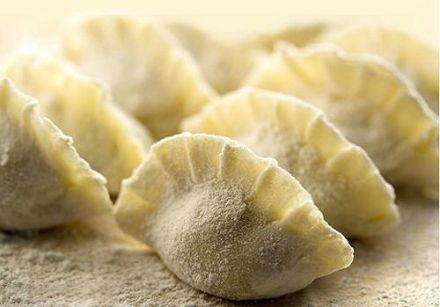Prep. time: 30 minutes
Cooking time: 30 minutes
New Year's Traditions
On New Year's Eve and New Year's Day, it is customary to eat dumplings, known as "jiaozi" in Chinese, which represent the progression of the years. They are filled and then boiled or steamed. In northern China they make "shui-chiao," shaping them like horseshoes, which is meant to bring riches to those who eat them. Plump half-moon shaped dumplings evoke "yuanbao," a 50 ounce silver ingot. Eating them is supposed to bring good luck and wealth.
Dumplings can contain a piece of sugar, a coin, a peanut or a chestnut, each filling signifying a different omen. Did you just bite into a sweet dumpling? Happiness will be knocking at your door. Did it contain a coin? Luck will smile on you. Is it stuffed with a chestnut? You'll soon have a boy. Is it filled with peanuts? That's a sign of longevity (in Chinese, peanuts are also called longevity fruit.)
Shopping
You can obtain fresh dumpling wrappers in Chinese groceries and frozen wrappers in some large grocery stores.
- Combine the flour and water; roll the dough out thinly on a work surface.
- Using a cutter, cut out rounds 12 cm (5") in diameter.
- Combine the ingredients for the filling.
- Place a small amount of filling in the center of each dough circle and fold over to form a plump semi-circle.
- Usually the traditional crescent moon shape is chosen. In this case, using the thumb and index finger of your right hand, roll the border of each dumpling, then using the thumb and index finger of each hand, press lightly to form the crescent. This step is called "modeling happiness." In some families, both ends are joined by curving the shape more in order to give it the shape of a silver ingot.
- Place the dumplings one at a time into a large pot of boiling water; once they rise to the surface, drain and transfer to a plate.
- Combine the ingredients for the sauce; serve in small individual dishes.


-

 Recipes
Recipes
-

 Products
Products
-

 Entertaining
Entertaining
-

 Chefs
Chefs
-

 Hints & Tips
Hints & Tips
-

 Glossaries
Glossaries









